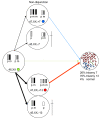Prenatal diagnosis of a trisomy 7/trisomy 13 mosaicism
- PMID: 22284936
- PMCID: PMC3293093
- DOI: 10.1186/1755-8166-5-8
Prenatal diagnosis of a trisomy 7/trisomy 13 mosaicism
Abstract
Double aneuploidy mosaicism of two different aneuploidy cell lines is rare. We describe for the first time a double trisomy mosaicism, involving chromosomes 7 and 13 in a fetus presenting with multiple congenital anomalies. No evidence for chimerism was found by DNA genotyping. The origin of both trisomies are consistent with isodisomy of maternal origin. Therefore, it is most likely that the double trisomy mosaicism arose from two independent events very early in embryonic development. The trisomy 7 and 13 cells were shown to be of maternal origin.
Figures


References
-
- Abe K, Harada N, Itoh T, Hirakawa O, Niikawa N. Trisomy 13/trisomy 18 mosaicism in an infant. Clin Genet. 1996;50:300–303. - PubMed
-
- Cogulu O, Tirpan C, Ozkinay F, Gunduz C, Ozkinay C. The second case with 47, XY, + 8 [38]/45, X0. Turk J Pediatr. 2002;44:86–89. - PubMed
-
- Eiben B, Hansen S, Goebel R, Hammans W. Tissue-specific 45, X0/47, XY, +13 mosaicism in an 18-year-old woman. Hum Genet. 1989;82:391–392. - PubMed
LinkOut - more resources
Full Text Sources

